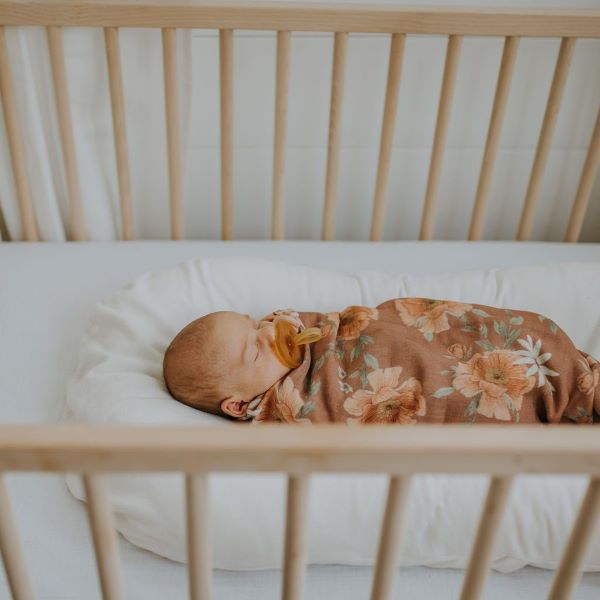Tips for Safe & Sound Sleep for the Whole Family
Sleep – or lack thereof - is a hot topic for parents of infants. Finding a balance between safe sleep and sound sleep can be tricky. With the right information and a few helpful tips, you can be confident that you are making the best decision for your family.
Making the Move: When? Where? How?
For sleep-deprived parents, every moment of sleep is a precious commodity. Finding the ideal arrangement for your family should be a carefully considered decision. When is the right time to transition a baby to their own bedroom? Where will your baby sleep best? How can you make the transition easier for everyone? These are questions that every parent has asked at some point. Read on for tips that can help you achieve safe and sound sleep for your growing family.
The Stats on Babies’ Sleep
Sudden Infant Death Syndrome (SIDS) is a tragic and terrifying reality that weighs heavily on the minds of all new parents. Providing a safe sleep environment is the first factor that should be considered when deciding where the baby will sleep. Many well-intentioned folks provide bad advice about what the “best” sleep environment for infants is. New parents may feel confused by the conflicting advice that they receive. Every family is different and has unique needs. Some parents need to be up very early for work. Some families have siblings to consider, and some people may feel that they miss out on intimate time. What is right for your family is a personal choice and may not be right for everyone. It is always best to discuss any questions or concerns with your pediatrician.
The American Academy of Pediatrics (AAP) recommends that babies share a room with their parents for the first 6 to 12 months of their life. Studies suggest that room-sharing significantly reduces the instance of SIDS (Sudden Infant Death Syndrome) for infants less than 1 year old. On the other hand, this report suggests that when babies are transitioned to their own room by 4 months of age, they and their parents get better sleep. Furthermore, the AAP acknowledges that parents of room-sharing babies are more likely to ignore other fundamental safe-sleep practices; they are more likely to provide soft bedding and are more likely to bring the baby into their own bed during the night.
A study published by the National Health Service (NHS) found that in the United States, 37.2% of infants, aged 6 to 12 months, slept in their own bedroom. Internationally, 48.4% of infants, aged 6 to 12 months, slept in their own bedroom. The researchers found that parents of babies who slept independently reported earlier and more consistent bedtimes, longer periods without waking up, and less perceived difficulty surrounding bedtime.
Safe Sleep – The Basics
Confused yet? So many studies, so many conflicting reports! Relax. Getting safe and sound sleep does not have to be stress-inducing. Here are a few basic recommendations that will keep your little one safe, regardless of what room they sleep in:
- Always place the baby on their back to sleep. Never on their stomach.
- Use a firm mattress and properly fitted sheets designed for infants.
- Never place toys, soft bedding, or loose fabrics in the crib with your baby
Sound Sleep – Helpful Hints
When you are ready to transition your baby to their own bedroom, you may wonder how you can make the process easier for everyone. Some babies, especially older babies, are upset when they first find themselves away from their parents. This may result in a few nights of restlessness and lost sleep for everyone. No parent wants to see their baby upset, but they can’t sleep with you forever. Rest assured that your baby will adjust to sleeping in their own room. Here are some helpful hints that can help your baby with the transition:
- Try swaddling. Babies feel safer when swaddled and are less likely to be woken by a startle reflex.
- Offer a pacifier. Pacifiers help soothe babies and have been shown to reduce the risk of SIDS.
- Use a white noise machine. Alternatively, fans provide white noise and increase air circulation.
- Baby monitors provide peace of mind for you. Video baby monitors allow you to look-in on the baby without disturbing them.
- Start with nap time. Placing babies in their own room for day-time naps may help them to adjust to sleeping alone.
- Familiarize the space. Increase the amount of time spent playing, reading, and changing your baby in their own room.
The Right Answer for Your Family
There is more than one right answer to the question of when to transition a baby to their own bedroom. Every family must make the decision based on their own unique circumstances. Safe and sound sleep is important to parents and babies. Sleep continues to be one of the most talked about topics among new parents. If you choose to have baby sleep in your room and transition them out when they are toddlers, here are some great night time tips for them. Please check out some of our other helpful articles about babies’ sleep and feel free to share your family’s experience in the comments section.





